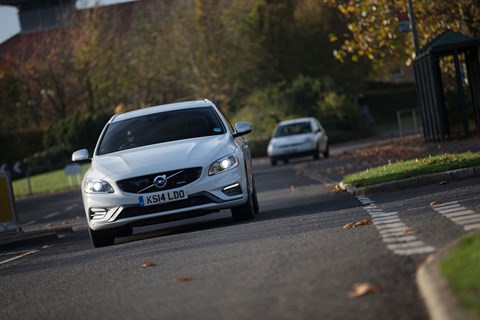► Long-term test diary of hybrid Volvo
► Diesel-electric powertrain impresses
► Price, dynamics, economy, not so much…
Month 11 running a Volvo V60 Plug-in Hybrid: the conclusion to our long-term test
When he mused that the whole is greater than the sum of its parts, Aristotle probably wasn’t thinking about Volvo’s V60 D6 R-Design Lux. But it’s an apposite philosophy for assessing our 13,853 miles in the world’s first diesel hybrid, one packed with tech and costing a princely sum: £51,675 before options (and before taking off its £5k green car subsidy).
Its parts are dominated by a fiendishly complex plug-in hybrid drivetrain, enabling electric rear-drive, five-cylinder diesel front-drive, or both for all-wheel drive. Volvo lauds electrification’s performance (as well as ecological) benefits, and boosting 325lb ft of diesel grunt with a 148lb ft electric motor makes for a punchy mid-range. But the two-tonne weight, supersized by 300kg of batteries, means it’s not as spritely as 6.1sec 0-62mph suggests.
More impressive is the sophisticated integration of the power sources. In Hybrid mode, an urban journey starts with pure electric, diesel powers you up a motorway slip road, then EV resumes to maintain a quiet cruise. Kick down and you unleash the diesel-electric full monty. At times you feel a tug on the front wheels like driveline shunt, as the engine takes over from e-drive, but mostly it’s seamless. Volvo has given the driver impressive control too, with a Pure button for EV mode, AWD to spin both axles, and a Save button which stores your current level of charge (or siphons engine power if the batteries need a top-up). These buttons provide superior interactivity to, say, Porsche’s Panamera e-Hybrid, and Volvo’s trip computer feedback is brilliant.
Ah, mpg! The discredited European cycle, which the D6 would have tackled fully charged with a 31-mile EV range, recorded 148.7mpg. My best, on a motorway run after a six-hour charge, was 61.2mpg; overall we averaged 44.9mpg. The V60’s finest hour was a 15-mile zero-emissions lap of London’s Congestion Charge zone.
The best hybrid cars and plug-in hybrids

You can hear a faint sci-fi whine at urban speeds; on the motorway the V60 is pretty refined, but tyre noise and wind whistle prevent Rolls-Royce rhapsodies of silence. Meaningful electric running, at speeds and for distances Toyota’s hybrids can’t currently match, engenders a proper feelgood factor.
Sadly it’s nothing but a feelbad factor when it comes to the V60’s dynamic qualities. The steering is a pig: you need a rugby forward’s strength to manhandle it at low speeds (though it can be inconsistently light in corners), and when you do wrestle it off centre, it has a furious determination to ping back to 12 o’clock. It makes the D6 feel unresponsive and understeery.
Drive hard, and you can feel the heavy rear batteries having a pendulous effect on chassis balance, though the front wheels hang on tenaciously. The ride is stiff, with crests and potholes jarring. No problems with the progressive-feeling brakes, unlike the snatchy response of some regenerative hybrid systems.
Read our guide to the best electric cars and EVs on sale in the UK
Option-wise, the £1900 Driver Support pack bundled together a mixed bag of safety kit. Active Beam was brilliant (ahem): simply leave high beam on, and be amazed as the mid-section of light drops out to avoid dazzling an oncoming driver, leaving a surrounding aura of brightness. Collision advoidance was clueless, often identifying parked cars or non-existent objects as hazards. But ‘city safe’ once activated the brakes just before I did, believing we were closing too fast on queuing traffic.
Reliability was mixed too: the front right brake screeched for a few days, though nothing was found to be grating, and the oil sensors flagged up an errant warning after the £288 first service. We also had a blowout, with the 18-inch Bridgestone costing £198 to replace, and the 12v battery had to be changed under warranty. In its last few days here, the hybrid system stopped taking any charge.
Ultimately these niggles, and the off-putting handling, make the V60 impossible to recommend. Shame, as its electric range makes it ideal for cities, while its diesel back-up eliminates an EV’s compromises. Splendid drivetrain, shame about the rest of it. Or as Aristotle would have more elegantly summarised: the whole is less than the sum of its parts.
By Phil McNamara
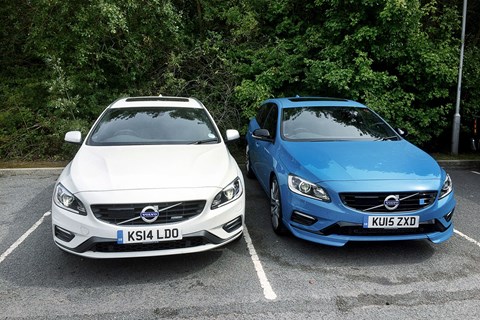
Month 10 running a Volvo V60 PHEV: ‘…and in some cases never picked at all’
Remember at school when captains would take it in turns to pick their players for the lunchtime kickabout? We have a similar nightly ritual on CAR to decide what we drive home. And if I’m not in the V60, its key hangs unloved in the box: it’s not last pick, it’s no pick.
Discussing its shortcomings (obstructive steering, jittery ride, no left foot) with CJ, he warmly recommended the V60 Polestar as a reference point. This is Volvo’s S4 Avant rival, with a 345bhp six, all-wheel drive, uprated suspension with Ohlins dampers, and Brembo brakes. The comparison is eye-opening – and teeth-rattling when it comes to ride quality. The Polestar’s suspension feels as unyielding and lashed down as an F1 car’s: the ride is brutal, whereas the hybrid’s primary ride is just busy and stiff-legged. Volvo says the Polestar’s steering is largely unchanged compared with the regular wagon’s, but it feels so deft and engaging compared with our aggressively self-centring and glutinous rack.
The Polestar’s exhaust sounds a charming thrum, and the turbocharged engine is good for 0-62mph in 5.0sec. It doesn’t feel blisteringly punchy; a criticism that can be leveled at the D6, whose 325lb ft of torque almost matches the Polestar’s, before being bolstered by the electric motor’s grunt. Both V60s share other traits too: portly frames and unruffled civility on a cruise.
By Phil McNamara
What is a hybrid car? Our guide to hybrids, PHEVs and plug-ins
Month 9 running a Volvo V60 hybrid: flat, mate
Rushing off to the Alfa Giulia premiere, I pressed the V60’s unlock button more firmly than a Georg Kacher stamp on a supercar throttle. But without the explosive results: the V60 was defiantly dormant. CJ was last to drive it: has the prankster removed the key fob battery? I jemmy the cap off the passenger door handle and insert the spindly back-up key, then clamber in to fire up the car. But with keyless start, there’s no ignition barrel: doh!
So the V60 stays in its EV bay for weeks, until I call Volvo’s roadside assistance cavalry. Technician Karl Richards arrives, reckoning the 12v battery that unlocks and helps start the car is flatter than a McLaren F1 team meeting. Ironic given that the V60 is plugged into the mains, to feed different battery cells which power the hybrid system. After 30mins’ charging off the drivetrain, the battery can still only muster 10v, so Karl takes it away and returns with a new battery under warranty. What caused this failure? We’re none the wiser.
By Phil McNamara
Month 8 running a Volvo V60: a dealer visit
Reach for the earplugs: the front right brake is screeching like fingernails down a blackboard. Classic intermittent problem, which disappeared only to start again after the V60 hit a speed bump. So at 15,000 miles, it’s time to act on that ‘maintenance required’ message.
I dropped the V60 off at Marshall Volvo in Peterborough, appreciating the onward lift to the office. When I returned, the freshly cleaned V60 was sporting £95 worth of new Castrol Edge, plus new air and oil filters; the service totalled £287.69. But despite a technician taking the V60 out for an exploratory trundle, there wasn’t a peep out of the brakes, and no telltale scoring or anything out of alignment. The pads were barely worn: a benefit of hybrid e-braking sharing the friction stoppers’ workload. Whatever the problem was, the wailing banshee has now been banished.
However, two days later and I’m greeted with ‘engine system service required’! Back to Marshall: the two oil sensors were giving conflicting readings, so they reset the system and drained a little oil, while I waited. No error messages since.
By Phil McNamara

Month 7 running a plug-in hybrid Volvo: can we apply for a home-charging grant?
Having gathered letters from Volvo and my boss confirming I’d run the V60 for the requisite six months, I applied to British Gas for a government-subsidised, 16-amp home-charger. £350 to charge the car in four hours. Before paying, I checked the small print, and emailed requesting clarity on ‘extras’ I might be liable for.
No response. I chased, to be told my application had been closed due to ‘no response from customer’. Scuppered by British Gas’s pitiful ‘computer says no’ mentality.
By Phil McNamara
Month 6 running a Volvo V60 PHEV: the great C-Charge zone challenge
‘There’s an old saying that victory has 100 fathers and defeat is an orphan,’ retorted President John Fitzgerald Kennedy, commenting while trying to avoid commenting on the failed, US-sponsored invasion of Cuba in 1961. Measured by sales success, Volvo’s V60 D6 plug-in hybrid is not over-blessed in the parent department either.
A couple of weeks ago, I asked Volvo’s UK boss where the crackpot impetus for the world’s first diesel hybrid came from. Blue sky session at The Elk and Wolf, or enormous government grant, I assumed (in fact, it was the lovechild of a four-year partnership with Swedish energy supplier Vattenfall AB). Nick Connor shrugged endearingly and answered in his best JFK: ‘It was developed at a time when we thought the European market for plug-in hybrids would be greater… A plug-in diesel was always going to be a fairly limited market.’
But hey, commercial success is not always the ultimate arbiter of an endearing product. Today, I will challenge the novel D6 to an equally novel test that only a handful of cars could tackle: to lap London’s Congestion Charge zone purely on electric power. No carbon emissions, not a drop of diesel consumed. It’s a challenge that’s even more pertinent now London mayor Boris Johnson has announced the eight-mile square area will become an Ultra Low Emission Zone from 2020, to tackle low-level smog linked to 4300 deaths a year.
First, some preparation. With its 48g/km of CO2 in the test lab, the D6 is Congestion Charge exempt. Except it’s not, unless you send off paperwork and pay a £10 registration fee to Transport for London. Resignedly, I pay the £10.50 daily charge.
Some 300kg of battery cells are packed into this V60’s boot, where the spare wheel might otherwise be, and housed in the lower sub-frame is the electric motor that spins the rear wheels. So in ‘pure’ electric mode, the V60 is rear-wheel drive. After five hours on the household mains last night, the D6’s water-cooled, 11.2kWh battery pack is fully charged.
So in the words of the Green Brother: ‘It’s 22 miles to central London, I’ve got 27 miles of electric range, half a packet of Polo mints, it’s sunny – and I’m wearing sunglasses: hit it!’ By ‘hit it’ I mean sheepishly prod the ‘Save’ button, to bank those 27 e-miles, and cruise down the M1 using diesel power.
It’s Volvo’s 212bhp five-cylinder engine that spins the front wheels, and puts the ‘D’ into D6. Reach for the Peltors to avoid the raucous grumble on start-up, and perhaps a gas mask: I notice an acrid diesel smell as the fiddly sat-nav accepted the Marylebone Road destination. The engine can also sound unrefined at part-loads, but roars mellifluously when you boot the throttle. It’s a pretty refined motorway cruiser, with the combination of tyre rumble and on-off wind whistle subsuming the engine.
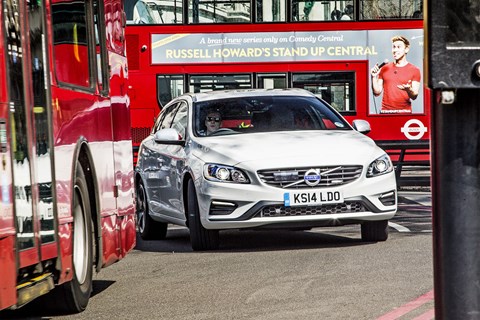
Off the M1 and into crawling traffic on the A5 towards Kilburn, and the D6 switches into pure electric mode. It’s utterly appropriate for the conditions, but not helping my range anxiety. Thankfully the diesel kicks in again within a couple of miles, and the hybrid system can recharge the batteries using kinetic energy from braking or by siphoning engine power.
The complex drivetrain’s smooth switching between power sources, and the broad operating range of electric assistance, is the most impressive aspect of the plug-in V60. The e-motor musters up to 148lb ft for the rear wheels, and can power the V60 past the motorway limit solo. And it’s so satisfying to watch the rev counter drop to zero at 70mph, as you coast along on e-power alone. Diesel front-drive, electric rear-drive or both united for all-wheel drive, this is a sophisticated system. There can be a slight judder when e-power switches to engine at motorway speeds though.
I reach the edge of the Congestion Charge zone, hitting the ‘Pure’ button to switch to solely electric power as I join the A501 Marylebone Road. Zero the trip, and use the ‘Power Flow’ display to check the battery pack’s projected range: 21 miles. One lap is about 10 miles, so that should be enough, congestion permitting…
The first 1.5 miles flow okay, and amid the red buses and soot-belching black taxis, I see another zero emissions warrior in an electric Renault Zoe. I feel like giving him a gesture of solidarity, but wonder how a Londoner will take a raised fist from a random bloke in a white Volvo. But traffic is crawling through4 the Euston underpass, so I hit the brakes. Initial ‘bite’ comes from the e-motor switching to generator mode and capturing kinetic energy as it slows the car, accompanied by a descending whine like Obi-Wan Kenobi powering down the Death Star’s tractor beam. Unlike on many hybrids, the progressive brakes don’t feel snatchy.
Every Volvo has City Safe operating at up to 31mph, where a grille-mounted laser measures the distance to obstacles ahead, triggering automatic braking if you’re about to rear-end someone. It leapt into action a few weeks back, having decided I wasn’t braking quickly enough in slowing traffic at a roundabout. While I’m contemplating having a ‘I would have stopped in time’ tattoo, it’s a reassuring safety net, ideal for this wild west (end) traffic. It’s more effective than the higher speed collision warning system I criticised last month.

Half-an-hour later, climbing the hill to Angel, the range is down to 15 miles. I shed my jumper, kill the air-con and decide to e-hypermile to conserve juice. Below 10mph the only sound is the motor’s sci-fi hum, but it’s swiftly drowned by tyre rumble. As if London driving isn’t stressful enough, I’ve a new neurosis: that twitchy pedestrians will step out in front of my silent, white iceberg.
Then disaster! A Crossrail development site near Liverpool Street diverts me off the ring-road, and by the time I’ve haplessly fumbled my way through the City, the V60 has drained another three unnecessary miles. More than an hour has elapsed, as I cross Tower Bridge with the Shard dominating my eyeline.
The stretch south of the river flows much better. The potholes come thick and fast, preying on the D6’s jarring ride and making my head shake. By Elephant and Castle, the range has fallen to six miles; another three have disappeared by the time I re-cross the Thames on Vauxhall bridge. Past Victoria station, onto Grosvenor Place beside Buckingham Palace, and three dashes have replaced a number to represent the remaining range. That can’t be a good thing. An orange Lamborghini Huracan undertakes: can’t imagine he worries about range anxiety.
Onto Park Lane, and the chequered flag is just over a mile away. But the diesel vibrates into life, an audible death rattle for our ambitions. I check the trip: the V60 has still aced 15 miles of pure electric driving, with the computer guesstimating fuel economy at 99.9mpg – as many digits as it can muster. In nearly two hours of driving, the plug-in V60 didn’t emit a single carbon.
It’s a victory for the V60’s parents at Volvo and Vattenfall, with only my wonky compass threatening to orphan the achievement. In central London, the plug-in V60 has found the place it can excel without compromise. Forget it’s a diesel estate with 300kg of batteries, and minimal boot. It’s a hybrid that performs like a pure electric car when it matters – but one that won’t leave you stranded when it doesn’t.
By Phil McNamara
Month 5 running a Volvo V60 Plug-in Hybrid: safety equipment cries wolf
The V60 has collision avoidance tech, as Volvo strives for zero serious accidents by 2020. Thanks to its distance-monitoring front radar and screen-mounted camera, this V60 warns if it thinks you’re on a collision course, and can then self-brake.
But like Mercedes’ system, it cries wolf. Empty stretches of motorway and parked cars around town have triggered more than a dozen false alarms of red flashing lights and deafening beeps. Zero fatalities? This ‘safety’ measure could kill me with an in-car heart attack.
By Phil McNamara
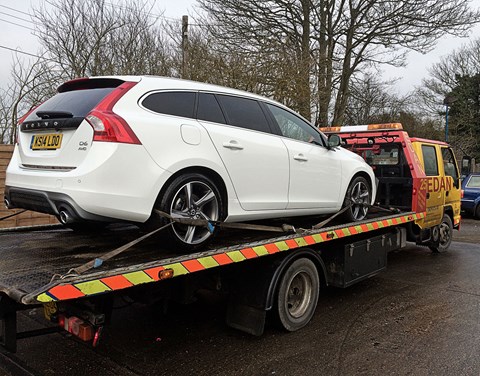
Month 4 running a Volvo V60 Plug-in Hybrid: what happens when you get a flat tyre?
Trouble: debris strewn across the Black Cat roundabout. Despite determined jinking, the front right tyre clipped some, and within five miles the wheel was vibrating like an Ann Summers party. So I pulled into Southoe Hand Car Wash; the smoking tyre had a cavity like a bludgeoned boiled egg.
The V60 hybrid’s boot doesn’t even have space for a can of sealant, given it’s packed with batteries and the e-motor spinning the rear axle, so I called Volvo Assistance. Megan took my details and said she’d scramble recovery within 90 minutes, to Marshall Volvo in Peterborough. Sure enough, the chirpy Graham from Edan Recovery arrived 92 minutes later. Which had left sufficient time for the hand wash chaps to clean the car, and for me to call ahead check Marshall had a Bridgestone Potenza 235/45 R18. They didn’t, but super-concierge James ordered one for afternoon delivery, checked to see if the lease company would authorise the £165 ex-VAT payment, and planned my onward transport to the office.
All told I lost two-and-a-half hours: not too bad given the circumstances, and soothed by great customer service all round. And I didn’t waste any further time, as Marshall’s James brought the reshod V60 back to the office – just in time for me to head home again.
By Phil McNamara
Month 3 running a Volvo V60 Plug-in Hybrid: economy improves to 60mpg
Having averaged 42.5mpg for the first couple of months – a shade off the 148.7mpg official consumption figure – it’s no more Mr Nasty Guy, Volvo. I am going to caress your throttle, tickle your brakes, and thrill you with my anticipation at roundabouts and traffic lights, all in a bid to maintain beautiful, fuel-saving momentum. And I’m going to cease my flirtations with racy red Performance mode, where the trip computer scored me an encouraging 61.2mpg on a fully-charged, 65-mile, rainy run home with wipers whirling.
A jab of indicator stalk buttons to toggle the driving modes in the classy binnacle and voila, Hybrid mode! Et zut alors: 61.1mpg on the same run – even though I was as gentle as the lamb leader of the ruminant branch of CND. Switching modes tweaks the throttle map and dials back the power delivery, though the ‘green’ settings don’t strangle the performance. Hybrid’s readout features a weird bubbling graphic when braking or coasting is charging the batteries; Performance mode is clearer thanks to novel tech: a rev counter! If the needle’s flat-lining, it means you’re on e-power and using no fuel.
Perhaps Eco mode will be my salvation: a new gauge appears, and the more measured your inputs, the more likely you are to surpass the eco driving marker. The A1M’s nearside lane becomes my friend, 71mph becomes my enemy: I don’t think I’ve ever cruised home seeing 65mph before. And to what end: 59.9mpg over the 65 miles!
My average for the two tanks climbed to 46mpg, but charging the car at home overnight could get me an instant 15mpg more. So I get onto British Gas, Volvo’s preferred supplier for a home charging point. If I apply before 31 March and have use of a hybrid/electric car for six months, the Office for Low Emission Vehicles will subsidise my installation by up to £900. According to British Gas, the cost to me would be a trifling £115 for a 16amp charger, or £214 for a 30amp charger, which would juice the V60 in five hours. Time to fill in the paperwork, and wait for the site visit to assess my suitability. Could this be the economy breakthrough…?
By Phil McNamara
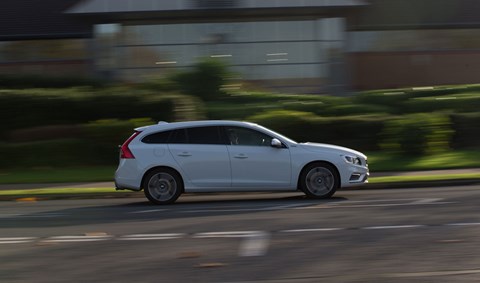
Month 2 running a Volvo V60 Plug-in Hybrid – the road test bit
High performance but low consumption, crammed with tech but simple to operate, that’s the mission of our Volvo V60 plug-in hybrid. How does it play out on the road?
The V60 spends weekdays A1 commuting. It’s no wallowy Volvo, in fact the ride is more knobbly than a porn convention. Over ridges, into potholes, the body bumps and grinds as the hybrid system’s weight flummoxes the stiff sports suspension. On high-frequency intrusions the leather can creak and the dashboard resonate. You also suffer a pronounced wind whistle, and plentiful tyre roar on scored surfaces.
Is this exaggerated by the silent running of the electric motor? No, NVH even subsumes the five-pot diesel’s gentle murmur at 70mph. The engine does clatter on start-up and at low revs, before rallying into a sonorous growl on kickdown. The hybrid V60 is punchy, especially in the mid-range, but it doesn’t quite feel 0-62mph-in-6.1sec-rapid.
Blame the extra 300kg heft from the hybrid system. When you get onto B-roads, the V60’s in its discomfort zone. In hard cornering, you can feel the weight transfer of the motor and batteries – all packed beneath the boot floor – preying on the chassis’s balance, more benign but still early-911-pendulous. Hit the ‘pure’ button and you can drive a charged V60 on rear-drive e-power, though press the stodgy throttle to tuck in the nose and the engine often fires. The front wheels generate hearty grip, but the heavy steering feels numb and knotty.
The decent brakes are more linear than the snatchy hybrid norm, with the e-motor gently slowing and charging before the friction brakes act. And hybrid integration is impressive: stick the auto ‘box in drive, switch the high-quality screens to display the power sources and mpg, and there is satisfaction to be had from trying to drive efficiently.
By Phil McNamara
Month 1 running a Volvo V60 Plug-in Hybrid – the introduction
I am not a geography teacher, I do not have a golden retriever, but my new set of wheels is a Volvo estate. And to make Guardian-reading liberals feel happier than a week without an Ed Milliband disaster, it’s the saintly, V60 Plug-in Hybrid, in new, sporty R-Design spec.
Volvo claims the V60 is the world’s first plug-in diesel: in countries such as Japan and the USA, the hybrid can be seen as the fuel-sipping equivalent to the diesel. But unlike that petrol/electric formula, Volvo has mated two expensive drivetrain elements together, to create the utterly exorbitant V60 D6 AWD Geartronic R-Design Lux Nav. It costs £51,675 before options! However, thanks to its meagre 48g/km CO2 rating – the V60 aces much of the undemanding, 6.8-mile New European Drive Cycle in pure electric mode – Volvo’s plug-in qualifies for a £5000 subsidy from the UK government. It’s road-tax and congestion-charge exempt too.
This car’s stand-out feature is its versatile drivetrain. A five-cylinder diesel spins the front wheels, with 212bhp peak power at 4000rpm and 325lb ft of torque at 1500rpm. Under the boot floor is an 11.2kW water-cooled battery pack and a single electric motor powering the rear wheels, with up to 69bhp and 148lb ft. The result is a smorgasbord of propulsion: electric rear-drive to get you motoring or maintain motorway cruising, front-drive five-pot if the batteries are depleted, or both in all-wheel drive maximum attack.
Volvo says ‘power’ mode is capable of 0-62mph in 6.1sec, the flipside is a preposterous 148.7mpg – blame the unfit NEDC test. We couldn’t even manage 48mpg over the first couple of tanks. A tight engine is not to blame: our ex-demo V60 arrived with 3559 miles on the clock. This V60 only gets its electric Ready Brek on weekdays, when I can hook it up to CAR’s chargepoints. Six hours on a 10amp charge gives a theoretical 31-mile electric range, though this V60 runs in ‘hybrid’ mode on my primarily motorway commute.
First impressions? The drivetrain is incredibly sophisticated: the diesel is smooth, and with the six-speed Geartronic automatic there’s no flaring of revs that once afflicted Lexus hybrids. The ride is a bit lumpy, steering response leisurely – I almost drove over my first roundabout, having not deployed sufficient lock – and you can feel how the extra 300kg weight impacts on dynamic sharpness.
The D6 R-Design Lux is the costliest V60, but this car manages a further £6475 on options. The £1900 Driver Support pack deploys a heap of automatic braking/seeing/steering aids you’d expect from safety-conscious Volvo: we’ll assess their interventions in due course. Then there’s the £675 Winter Illumination Pack, which includes heated seats and front windscreen, bending headlamp beam and some fancy interior lights. Heated seats not being standard on a £50k car?! Nor is keyless drive (£550), powered passenger seat (£400), front and rear park assist (£325), which seems like grand larceny.
Chuck in an £850 sunroof (the dark interior is crying out for a large glass panel), £350 rear privacy glass, £500 R-Design leather and £500 Sensus Connect, which hooks up the car for web-based services, and all hail the £58,150 Volvo! What’ll it be worth in 11 months? Will it ever crack 50mpg? And can we cross London on solely electric power? Stay tuned to find out…
By Phil McNamara
